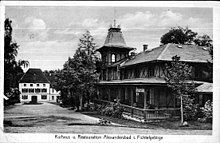Emil Cordes
Jochim Emil Cordes (born August 20, 1829 in Lübeck , † October 11, 1900 in Munich ) was a German doctor of the 19th century.
Life
Cordes came from a merchant family; his father Johann Jochim Cordes (1782–1866) was a partner in the Lübeck trading company JG Nöltingk & Cordes , his mother Emilie Christiane, geb. Grautoff (1790–1849) was a pastor's daughter from Kirchwerder and the sister of Ferdinand Heinrich Grautoff . The painter Johann Wilhelm Cordes was his older brother. He attended the Katharineum in Lübeck and began studying medicine in 1849. In 1851 he became a member of the Corps Nassovia Würzburg at the University of Würzburg . At the University of Berlin he received his doctorate in 1853. med. with a dissertationabout rheumatism . After a trip to America, he also passed his medical state examination in Berlin in 1857. He settled in his hometown as a doctor and also looked after the Lübeck military on a part-time basis , most recently as senior doctor since 1863. During his time in Lübeck, the hygienic conditions in the city were of particular concern to him. Lübeck has also suffered from regular epidemics since the emergence of cholera in Central Europe around 1830 . Cordes examined the groundwater and the drinking water supply of the city and, as a result of his studies, campaigned for improvements in sewage disposal and he drinking water supply (see Lübecker Wasserkunst (1867) ), so that in Lübeck after the implementation of the measures from 1866 cholera no longer broke out.
In the spring of 1868, Cordes became head of the Bad Alexandersbad spa in the Fichtel Mountains , which he bought shortly afterwards as a facility in Alexandersbad Palace . He spent the season from mid-May to October here, he took up his winter residence in Munich in Lehel at Bruderstraße 9. In 1881 he was able to take over the Stahlbad , also located in Alexandersbad, while simultaneously founding a stock corporation ; In 1884 he had a new spa house built. From the mid-1880s, doctors employed in the business ran the business in Alexandersbad. Cordes concentrated on his practice in Munich, where he turned to psychiatry . As early as 1872 he published one of the basic descriptions of agoraphobia (claustrophobia).
In recognition of his services, Cordes was appointed royal Bavarian councilor . He was keenly interested in art and culture and belonged to a circle of friends around the poet Paul Heyse . He bequeathed his brother's artistic estate, which he inherited after his death in 1869, to the museum in Lübeck. Today it is part of the collections of the Behnhaus Museum in Lübeck.
Fonts
- De acuto et chronico articulorum rheumatismo: dissertatio inauguralis medica. Schlesinger, 1853.
- Cholera in Lübeck: a few words to patriotism and the authorities; together with a map of the city, containing the deaths in the individual streets. Asschenfeldt, Lübeck 1861.
- Illumination of the draft medical regulations for the Free State of Lübeck. Lübeck 1866.
- Cholera in Lübeck. Munich 1868.
- Claustrophobia (agoraphobia), symptom of paresis of exhaustion. In: Archives for Psychiatry and Nervous Diseases. 3 (1872), pp. 521-574.
- Prospect of the hydropathic institute in Alexandersbad in the Fichtelgebirge kgl.Bayer. District of Upper Franconia. 1875.
literature
- Hubertus Averbeck: From the cold water cure to physical therapy: considerations about people and the time of the most important developments in the 19th century. Europäische Hochschulverlag, Bremen 2012, ISBN 978-3-86741-782-2 , pp. 405f.
- Dietrich Helm: Cordes, Jochim Emil. In: Alken Bruns (Ed.): Lübeck resumes . Wachholtz, Neumünster 1993, ISBN 3-529-02729-4 , pp. 74 f.
- F. Kohl: The classic descriptions of claustrophobia by Carl Westphal and Emil Cordes and their significance for the history of the concept and current discussion of anxiety disorders. In: Psychiatric Practice. 28 (2001), pp. 3-9.
Individual evidence
- ↑ Second museum lecture. In: Lübeckische Blätter 43 (1901), p. 628f.
- ↑ Kösener Corpslisten 1960, 142 , 116.
| personal data | |
|---|---|
| SURNAME | Cordes, Emil |
| ALTERNATIVE NAMES | Cordes, Jochim Emil (full name); Cordes, Joachimus Aemilius |
| BRIEF DESCRIPTION | German medic |
| DATE OF BIRTH | August 20, 1829 |
| PLACE OF BIRTH | Lübeck |
| DATE OF DEATH | October 11, 1900 |
| Place of death | Munich |
